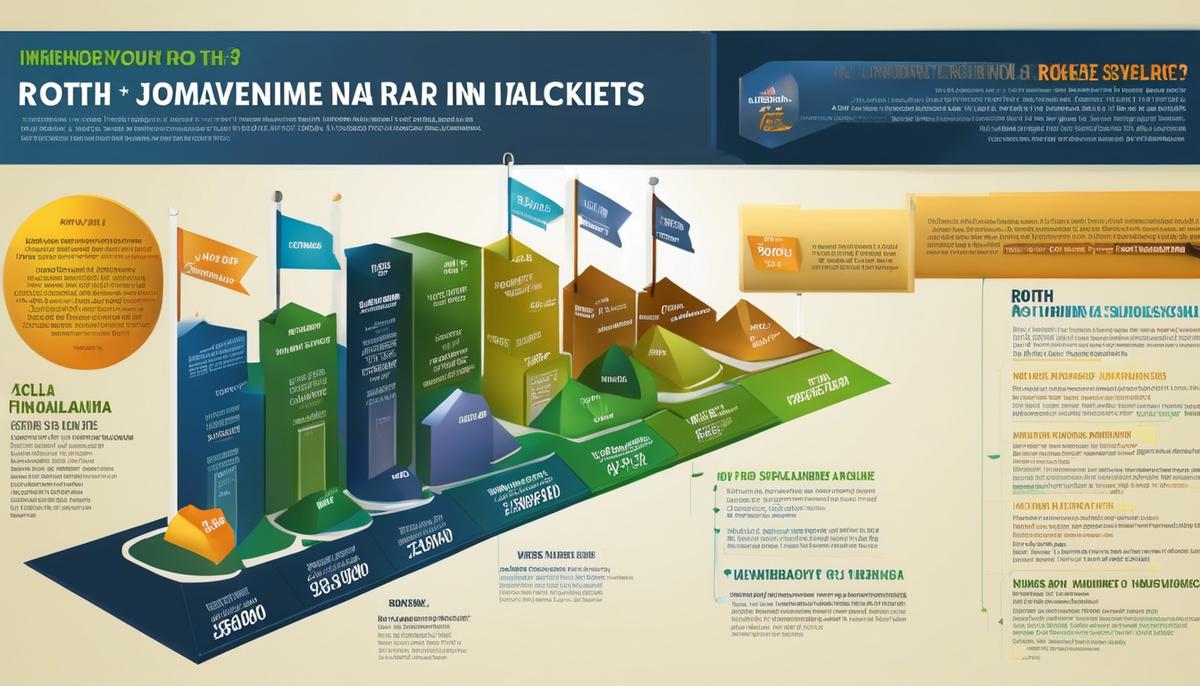Roth IRA Changes in 2024
As we gaze into the financial horizon of 2024, the landscape of Roth Individual Retirement Accounts (IRAs) is poised to undergo pivotal transformations that will reshape the way we save for retirement. For those committed to securing their financial future, understanding the Roth IRA changes is more than prudent—it’s a strategic imperative. This essay aims to navigate the intricacies of these updates, starting with the revised contribution limits. These aren’t mere numbers; they are the hallmarks of a well-informed investment strategy, arming you with the knowledge to capitalize on tax-free growth and secure withdrawals. Through a meticulous examination of income eligibility modifications, withdrawal rule revisions, and the tax implications and strategies therein, you’ll become versed in the art of optimizing your retirement savings in a tax-efficient manner, making every dollar in your Roth IRA work relentlessly on your behalf.
Updated Contribution Limits
Raising the Roof: The New Max on Roth IRA Contributions
Entrepreneurs, savers, investors – lend your ears! In the bustling world of personal finance, a game-changing shift silently rolled out, and it’s imperative that you wrap your financial acumen around it – pronto. You’re familiar with Roth IRAs, the darling of savvy retirement planners that allow tax-free growth and withdrawals. Well, prepare to adjust your strategies and spreadsheets: there’s been an exciting increase in the contribution limits.
Let’s cut to chase. For the tax year 2023, the maximum you can contribute to a Roth IRA jumps up to $6,500 for those under the age of 50. If you’ve celebrated the big 5-0 or are dancing beyond, catch-up contributions come into play, lifting your potential investment to $7,500. That’s $500 more across the board from 2022, folks! It’s time to leverage this bump.
This ceiling hike isn’t just a random number increase; it’s an adjustment for inflation, helping your retirement savings maintain purchasing power in an ever-dynamic economic landscape. And, for the high-rollers who understand the fine print, income limits for contributions have also shifted upwards. Singles with modified adjusted gross incomes up to $153,000 can make full contributions, with phaseouts starting there and capping at $218,000. Joint filers, you’re looking at a generous starting phaseout range of $228,000, ending at $228,000.
There’s an art and science to maximizing Roth IRAs. Entrepreneurs like you, who are always eyeing growth and opportunities, can appreciate the Roth’s flexibility. With no mandatory distributions and the ability to continue contributions regardless of age – as long as you have earned income – this is a prime vessel for building a robust, tax-advantaged nest egg.
Receive this as a call to action. Whether you’re a young gun at the springboard of your professional journey or a seasoned veteran optimizing the golden years horizon, this ceiling lift is your green light. Maximize your contributions, strategize with advisors, and let this incremental increase work as diligently for your future as you do for your business today.
Remember, in the world of finance, being informed is not enough. Action is the true currency of the wise. Take advantage – your future retired self will thank you, probably from a beach chair or a mountain cabin, courtesy of strategic planning and the new Roth IRA thresholds.

Income Eligibility Modifications
Navigating the New Terrain: Your Roth IRA Under Updated Income Brackets
In the dynamic landscape of investments, Roth IRAs stand as beacons of tax-efficient planning for discerning savers and investors alike. However, as the winds of change usher in new income brackets, it’s essential to grasp their implications on your financial strategy – particularly your Roth IRA.
Flexibility is a hallmark of successful business, and the same applies to personal finance. The income brackets, pivotal in deciding who’s eligible to fuel their Roth IRA’s growth, have shifted. And with these shifts come opportunities and considerations that cannot be overlooked.
First, let’s talk about the immediate impact: higher income thresholds permit a greater number of investors to participate in Roth IRAs, known for their tax-free withdrawals at retirement. For the go-getters and up-and-comers climbing the income ladder, this is welcome news. You may find that you are now eligible to contribute where previously you were not, giving you a new tool in your arsenal for retirement savings.
For high earners already contributing to Roth IRAs, you’ll find more room to maneuver. Although direct contributions phase out at higher income levels, the increased brackets may enable you to contribute more directly to your Roth IRA before reaching the limit.
Strategy is everything, and with the new income brackets in play, it’s worth revisiting yours. Savvy investors might consider a backdoor Roth IRA strategy: make contributions to a traditional IRA and then convert to a Roth, bypassing income limits. While complexities exist, including potential tax implications, this underscores the importance of shrewd financial planning in partnership with a trusted advisor.
Furthermore, entrepreneurs and professionals with fluctuating incomes should remain vigilant. Your eligibility to contribute to a Roth IRA can change from year to year as your income ebbs and flows. In a year of higher earnings, you might phase out of direct contributions, making strategic tax planning even more pivotal to maximize benefits.
The takeaway is clear: the updated income brackets represent not only shifts in the financial landscape but also signal opportunities for those who keep their finger on the pulse of their financial health. This is the time to retune your retirement strategy to align with the current regime – ensuring your Roth IRA remains a robust component of your wealth-building journey.

Withdrawal Rule Revisions
Navigating the Nuances: Accessing Roth IRA Funds in the New Financial Terrain
In a dynamic financial environment, understanding the nuances of Roth IRA withdrawal regulations is paramount for the savvy investor. While Roth IRAs are appealing for their tax-free growth and distributions, certain criteria must be met to fully benefit from these features.
Firstly, one must be attuned to the five-year rule for earnings. Contributions to a Roth IRA can always be withdrawn tax and penalty-free. However, earnings on those contributions are subject to taxes and penalties if withdrawn before five years have elapsed since the initial contribution to any Roth IRA account.
Moreover, to withdraw earnings free of taxes and penalties, the account holder must be age 59½ or older, unless a qualifying exception applies. Be aware that the IRS outlines specific exceptions, such as using up to $10,000 of IRA funds towards a first-time home purchase, that permit early withdrawals without the usual penalties.
It’s crucial for those transferring funds to understand that conversions from Traditional IRAs to Roth IRAs have their own five-year rule. Each conversion has its own clock, starting with the year when the conversion occurred.
For those inheriting Roth IRAs, the rules differ again. Non-spouse beneficiaries are required to empty the account within 10 years, with no minimum distribution required each year. This update from the SECURE Act, which took effect in 2020, necessitates strategic planning to minimize the tax impact of these distributions.
It’s incumbent upon those with Roth IRAs to remain abreast of these regulations and to align their withdrawal strategies with their financial goals. Consulting with a tax professional or financial advisor can ensure that one’s actions are both compliant and strategically sound.
The entrepreneurial mind understands that opportunities and pitfalls lie within the details. Staying informed on the evolving rules governing Roth IRAs is not just prudent—it’s a strategic imperative for those committed to optimizing their financial future. In the quest for financial acumen, let this deep dive into the world of Roth IRAs be a new pivot point for financial strategy and prosperity.

Tax Implications and Strategies

Photo by foodistika on Unsplash
Mastering the changes to Roth IRAs in 2024 is akin to charting a course through ever-evolving financial waters—requiring vigilance, adaptability, and foresight. By now, you should stand on a vantage point where updated contribution limits, income eligibility modifications, withdrawal rule revisions, and the nuanced landscape of tax implications and strategies are clear in your sight. These insights are your compass and map in the realm of retirement planning; use them to steer your course confidently towards a prosperous financial future. With these changes demystified and your knowledge enriched, you’re now empowered to navigate the realms of Roth IRAs with an informed mind and an adept hand, ensuring that your retirement journey is as rewarding as the destination itself.



Leave a Reply